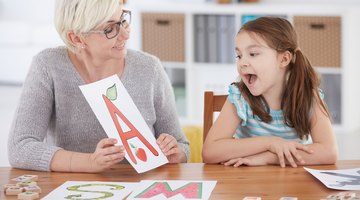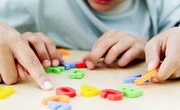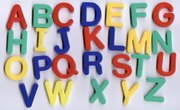The origins of the English language are varied, often making spelling and reading challenging for young learners. By learning specific components such as vowel clusters, kids have a stronger foundation for both reading and spelling skills. To build on this foundation, teach kids vowel clusters with systematic instruction, provide reading examples that emphasize the target cluster and give them chances to practice their new skills.
Vowel Clusters
Vowel clusters occur in words with adjoining vowels. These vowel combinations are associated with specific sounds. For example, the "ee" spelling denotes a long "e" sound, as in "queen." When the two vowels work together to make a single sound, as in queen, this is often called a vowel digraph. Vowel diphthongs occur when the vowels create a complex gliding sound from one vowel to another, as in "out." Publishers such as Rigby put out phonics cards that include useful phrases to help children remember these sounds. For example, kids learn "Double-e always says 'ee,'" for the "ee" digraph.
Phonics
Phonics is one of the schools of thought for reading teachers. Phonics instruction has teachers explicitly show students how to pronounce and read words based on individual components such as vowel clusters. When putting phonics into use, apply phonics instruction systematically. Start by introducing the vowel clusters and their sounds. Once kids also know the consonants, begin blending the vowel clusters with the consonants until the students can read the whole word. For instance, in teaching "queen," start with the long "e" sound of "ee." If kids already know the sounds for "qu" and "n," blend the word together until they read "queen."
Spelling and Reading
Spelling and reading go hand in hand. So much of the underlying knowledge that goes into learning how to spell also helps kids learn how to read. For example, both skills rely on the understanding of the letter-sound relationship, so teach kids the vowel clusters systematically and reinforce by using flash cards. Synthesize that knowledge by utilizing decodable books featuring the target cluster. For instance, Reading A-Z offers the book "The Bee and the Flea," which allows children to read a fictional story that also offers passive practice of the cluster. Read the book with the child first, emphasizing the target cluster, then help her read the book herself.
Activities
Kids need a lot of practice to fully learn a new concept. Have students start with spelling worksheets. For this activity, children start by tracing, then writing the target word, such as "queen." They then circle other words in a given set that feature the target combination, such as "feet" and "seed." To make learning enjoyable, thus cementing their new knowledge, allow kids to play games related to the vowel clusters. They can use their flash cards to play memory, as well as Go Fish. As a group, have students play bingo. Generate boards with words containing various clusters, so that students have to decode the spelled word. To assess their understanding of vowel clusters, give kids a list of words containing different clusters. Have them read the list aloud, marking any they miss. Reteach any clusters kids consistently miss.
Related Articles
References
Writer Bio
Nadia Archuleta has a B.A. in English writing. She spent five years working abroad and has traveled extensively. She has worked as an English as a Foreign/Second Language teacher for 12 years.











